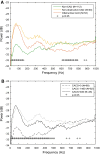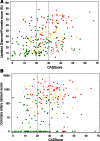Diagnosing coronary artery disease by sound analysis from coronary stenosis induced turbulent blood flow: diagnostic performance in patients with stable angina pectoris
- PMID: 26335368
- PMCID: PMC4737789
- DOI: 10.1007/s10554-015-0753-4
Diagnosing coronary artery disease by sound analysis from coronary stenosis induced turbulent blood flow: diagnostic performance in patients with stable angina pectoris
Abstract
Optimizing risk assessment may reduce use of advanced diagnostic testing in patients with symptoms suggestive of stable coronary artery disease (CAD). Detection of diastolic murmurs from post-stenotic coronary turbulence with an acoustic sensor placed on the chest wall can serve as an easy, safe, and low-cost supplement to assist in the diagnosis of CAD. The aim of this study was to evaluate the diagnostic accuracy of an acoustic test (CAD-score) to detect CAD and compare it to clinical risk stratification and coronary artery calcium score (CACS). We prospectively enrolled patients with symptoms of CAD referred to either coronary computed tomography or invasive coronary angiography (ICA). All patients were tested with the CAD-score system. Obstructive CAD was defined as more than 50 % diameter stenosis diagnosed by quantitative analysis of the ICA. In total, 255 patients were included and obstructive CAD was diagnosed in 63 patients (28 %). Diagnostic accuracy evaluated by receiver operating characteristic curves was 72 % for the CAD-score, which was similar to the Diamond-Forrester clinical risk stratification score, 79 % (p = 0.12), but lower than CACS, 86 % (p < 0.01). Combining the CAD-score and Diamond-Forrester score, AUC increased to 82 %, which was significantly higher than the standalone CAD-score (p < 0.01) and Diamond-Forrester score (p < 0.05). Addition of the CAD-score to the Diamond-Forrester score increased correct reclassification, categorical net-reclassification index = 0.31 (p < 0.01). This study demonstrates the potential use of an acoustic system to identify CAD. The combination of clinical risk scores and an acoustic test seems to optimize patient selection for diagnostic investigation.
Keywords: Angina pectoris; Cardiovascular diagnostic technic; Coronary artery disease; Heart sounds; Sensitivity and specificity.
Figures





References
-
- Zimmermann H, Schmidt SE, Hansen J, Hammershøi D, Møller H. Acoustic coupler for acquisition of coronary artery murmurs. Comput Cardiol. 2011;38:209–212.
Publication types
MeSH terms
LinkOut - more resources
Full Text Sources
Other Literature Sources
Medical
Miscellaneous

